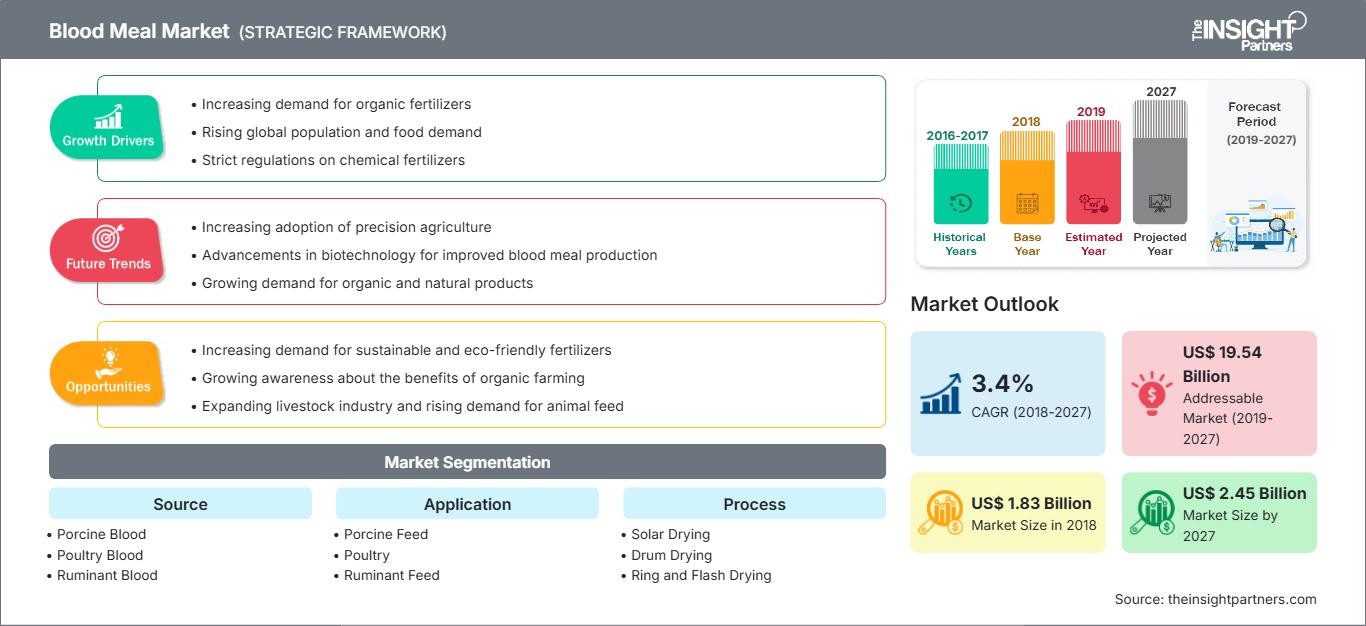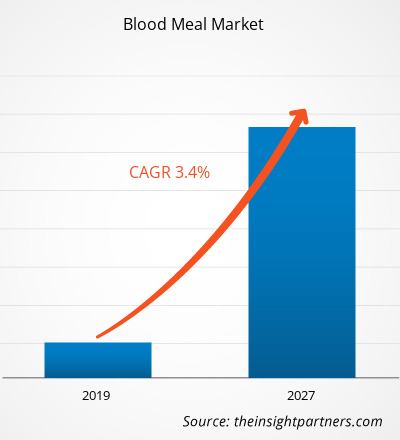Der Markt für Blutmehl wurde 2018 auf 1.825,9 Millionen US-Dollar geschätzt und soll bis 2027 2.451,6 Millionen US-Dollar erreichen; von 2019 bis 2027 wird ein CAGR-Wachstum von 3,4 % prognostiziert.
Blutmehl ist ein getrocknetes und inertes Pulver, das unter ganz bestimmten Bedingungen aus dem Blut verschiedener Nutztiere, darunter Rinder, Schweine und Hühner, hergestellt wird. Es wird als organischer Dünger mit hohem Stickstoffgehalt und als proteinreiches Futtermittel für Tiere verwendet. Es gilt als eine der reichhaltigsten nicht-synthetischen Stickstoffquellen. Blutmehl wird als Nahrungsergänzungsmittel für Nutztiere verwendet und ist hauptsächlich in der Versorgung von Nutztieren mit Lysin enthalten. Knochenmehl, Blutmehl und andere tierische Nebenprodukte sind in der zertifizierten ökologischen Produktion zugelassen, hauptsächlich als Bodenverbesserungsmittel. Blutmehl ist ein weiteres Knochenmehl; Blutmehl enthält jedoch einen höheren Stickstoffgehalt, während Knochenmehl Phosphor enthält. Blutmehl wird außerdem als Kompostierungsaktivator verwendet. Blutmehl kann auch in Gärten ausgebracht werden, um Schädlinge wie Kaninchen fernzuhalten.
Der Blutmehlmarkt in Nordamerika wird im Prognosezeitraum voraussichtlich mit einer jährlichen Wachstumsrate von 4,1 % wachsen. Das Wachstum der Viehwirtschaft spielt eine entscheidende Rolle bei der Deckung des steigenden Nahrungsmittelbedarfs. Blutmehl wird in der Tierfutterindustrie häufig als Fischfutter, Wiederkäuerfutter und Geflügelfutter verwendet. Produktion und Verbrauch von Blutmehl nehmen in den USA aufgrund der steigenden Nachfrage nach gesunden Lebensmitteln und der zunehmenden Wertschätzung von Bio-Produkten weiter zu. Das steigende verfügbare Pro-Kopf-Einkommen der Verbraucher motiviert sie zusätzlich, sich auf gesunde Futtermittelzutaten zu freuen, was das Marktwachstum voraussichtlich ankurbeln wird. Die meisten Hersteller nutzen zudem die Vorteile der Verwendung kostengünstigerer Zutaten wie Blutmehl in Tierfutter.
Passen Sie diesen Bericht Ihren Anforderungen an
Sie erhalten kostenlos Anpassungen an jedem Bericht, einschließlich Teilen dieses Berichts oder einer Analyse auf Länderebene, eines Excel-Datenpakets sowie tolle Angebote und Rabatte für Start-ups und Universitäten.
Blutmahlzeitmarkt: Strategische Einblicke

-
Holen Sie sich die wichtigsten Markttrends aus diesem Bericht.Dieses KOSTENLOSE Beispiel umfasst Datenanalysen, die von Markttrends bis hin zu Schätzungen und Prognosen reichen.
Der jüngste COVID-19-Ausbruch begann im Dezember 2019 in Wuhan (China) und hat sich seitdem rasant in allen Regionen der Welt verbreitet. Im Mai 2020 gehörten die USA, Indien, Brasilien, Russland, Spanien, Großbritannien und einige andere Länder hinsichtlich bestätigter Fälle und gemeldeter Todesfälle zu den am schlimmsten betroffenen Ländern. Der Ausbruch hat die Volkswirtschaften in verschiedenen Ländern aufgrund von Ausgangssperren, Reiseverboten und Geschäftsschließungen – sogenannte Schutzmaßnahmen zur Eindämmung der COVID-19-Ausbreitung – beeinträchtigt. Die Lebensmittelindustrie gilt als einer der weltweit größten Industriezweige, die aufgrund dieses Ausbruchs unter schweren Fabrikschließungen, Lieferkettenunterbrechungen, Absagen von Technologieveranstaltungen und Büroschließungen leidet. Auch wenn einige Hersteller versuchen, ihre Verluste durch die Umsetzung neuer Strategien auszugleichen, wird es einige Zeit dauern, die pandemiebedingten Verluste zu überwinden.
Markteinblicke: Steigende Nachfrage nach nahrhaftem Futter
Blut wird aufgrund seines hohen Proteingehalts als flüssiges Protein verwendet und ist reich an Aminosäuren wie Lysin. Es hat Vorteile gegenüber pflanzlichem Protein, das einen niedrigen Lysingehalt aufweist. Zu den Faktoren, die das Wachstum des Blutmehlmarktes beeinflussen, gehören der Anstieg des verfügbaren Pro-Kopf-Einkommens der Bevölkerung, ein hoher Lebensstandard, die wachsende Nachfrage nach tierischen Proteinen und die Tendenz, Bio-Produkte zu bevorzugen. Darüber hinaus schafft das Wachstum der Aquakultur auch die Nachfrage nach nahrhaftem Futter. Es gibt auch eine steigende Nachfrage nach Fleischprodukten und eine Zunahme der Schlachtungen von Tieren, was den Blutmehlproduzenten weitere verschiedene Möglichkeiten eröffnet. Der anhaltende „Bio-Trend“ erwies sich ebenfalls als positiver Faktor für diesen Markt. Landwirte verwenden Blutmehl als natürlichen Dünger, da es Stickstoff enthält. Die zahlreichen Vorteile von Blutmehl dürften das Marktwachstum im Prognosezeitraum ankurbeln.
Quellenbasierte Erkenntnisse
Der Blutmehlmarkt ist nach Quelle in Schweineblut, Geflügelblut und Wiederkäuerblut unterteilt. Das Geflügelblutsegment hatte 2018 den größten Marktanteil und wird im Prognosezeitraum voraussichtlich die höchste durchschnittliche jährliche Wachstumsrate (CAGR) aufweisen. Geflügelblut ist aufgrund seines hohen Aminosäuregehalts, insbesondere Lysin, der am häufigsten verwendete Rohstoff zur Herstellung von Blutmehl. Geflügelblutmehl ist eine natürliche Proteinquelle, die als Zutat in Tierfutter verwendet wird, hauptsächlich für Schweine, Geflügel, Fische und andere Nichtwiederkäuer. Der Rohstoff wird grundsätzlich in Schlachthöfen gesammelt und in Geflügelverarbeitungsanlagen verarbeitet. Das Blutmehl ist frei von Zusatzstoffen, die das natürliche Protein verbessern.
Anwendungsbasierte Erkenntnisse
Der Blutmehlmarkt ist je nach Anwendung in Schweinefutter, Geflügelfutter, Wiederkäuerfutter, Aquakulturfutter und Sonstiges unterteilt. Das Segment Schweinefutter hatte 2018 den größten Marktanteil, während für das Aquakulturfuttersegment im Prognosezeitraum die höchste durchschnittliche jährliche Wachstumsrate erwartet wird. Sprühgetrocknetes Schweineplasma wird durch folgende Prozesse hergestellt: Blut von geschlachteten Schweinen wird gesammelt und einem Antikoagulans, in der Regel Natriumcitrat, zugesetzt. Anschließend wird es zentrifugiert, um die Erythrozyten zu entfernen. Das gesammelte Plasma wird anschließend sprühgetrocknet und zur Herstellung von Tierfutter verwendet.
Prozessbasierte Erkenntnisse
Der Blutmehlmarkt ist je nach Prozess in Solartrocknung, Trommeltrocknung, Ring- und Blitztrocknung sowie Sprühtrocknung unterteilt. Das Segment Ring- und Schnelltrocknung hatte 2018 den größten Marktanteil, während das Segment Solartrocknung im Prognosezeitraum voraussichtlich die höchste durchschnittliche jährliche Wachstumsrate (CAGR) verzeichnen wird. Das Blut wird zunächst in einen Hochgeschwindigkeits-Venturi-Abschnitt des Systems geleitet. Das Blut wird zunächst dem heißen Trocknungsluftstrom zugeführt, dann verdampft es. Sobald das Produkt durch die Trocknungssäule nach oben befördert wird, wird es weiter getrocknet. Das Ringtrocknungssystem unterscheidet sich hauptsächlich durch einen internen Klassierer vom Schnelltrockner. Bei der Ringtrocknung wird das Blut durch Erhitzen mit Dampf koaguliert; das Koagulum wird zentrifugiert und in einem Ringtrockner mit heißem Gas getrocknet. Das ringgetrocknete Blutmehl bietet einen höheren Gesamtvolumengehalt und ist aufgrund der enthaltenen Aminosäuren von besserer Nährstoffqualität. Beispielsweise beträgt die Lysinverfügbarkeit bei ringgetrocknetem Blutmehl 84 bis 89 %, bei chargengetrocknetem Blutmehl hingegen nur 62 bis 77 %.
Fusionen und Übernahmen sowie Forschung und Entwicklung sind die gängigen Strategien von Unternehmen, um ihre Präsenz weltweit zu erweitern, was sich weiter auf die Größe des Marktes auswirkt. Akteure auf dem Blutmehlmarkt wie Ridley Corporation Limited setzen die oben genannten Strategien um, um ihren Kundenstamm zu erweitern und bedeutende Marktanteile auf dem Weltmarkt zu gewinnen, was ihnen auch ermöglicht, ihren Markennamen weltweit zu behaupten.
Blutmahlzeitmarkt
Die Analysten von The Insight Partners haben die regionalen Trends und Faktoren, die den Blutmehlmarkt im Prognosezeitraum beeinflussen, ausführlich erläutert. In diesem Abschnitt werden auch die Marktsegmente und die geografische Lage in Nordamerika, Europa, dem asiatisch-pazifischen Raum, dem Nahen Osten und Afrika sowie Süd- und Mittelamerika erörtert.Umfang des Marktberichts zu Blutmehl
| Berichtsattribut | Einzelheiten |
|---|---|
| Marktgröße in 2018 | US$ 1.83 Billion |
| Marktgröße nach 2027 | US$ 2.45 Billion |
| Globale CAGR (2018 - 2027) | 3.4% |
| Historische Daten | 2016-2017 |
| Prognosezeitraum | 2019-2027 |
| Abgedeckte Segmente |
By Quelle
|
| Abgedeckte Regionen und Länder |
Nordamerika
|
| Marktführer und wichtige Unternehmensprofile |
|
Dichte der Marktteilnehmer für Blutmahlzeiten: Verständnis ihrer Auswirkungen auf die Geschäftsdynamik
Der Markt für Blutmehl wächst rasant, angetrieben durch die steigende Endverbrauchernachfrage aufgrund von Faktoren wie sich verändernden Verbraucherpräferenzen, technologischem Fortschritt und einem stärkeren Bewusstsein für die Vorteile des Produkts. Mit der steigenden Nachfrage erweitern Unternehmen ihr Angebot, entwickeln Innovationen, um den Bedürfnissen der Verbraucher gerecht zu werden, und nutzen neue Trends, was das Marktwachstum weiter ankurbelt.

- Holen Sie sich die Blutmahlzeitmarkt Übersicht der wichtigsten Akteure
- Fortschreitende Branchentrends im globalen Blutmehlmarkt, um Akteuren bei der Entwicklung effektiver langfristiger Strategien zu helfen
- Geschäftswachstumsstrategien von Unternehmen in entwickelten und sich entwickelnden Märkten
- Quantitative Analyse des globalen Blutmehlmarktes von 2017 bis 2027
- Schätzung der globalen Nachfrage nach Blutmehl durch verschiedene Branchen
- PEST-Analyse zur Veranschaulichung der Wirksamkeit von Käufern und Lieferanten, die im Blutmehl-Ökosystem tätig sind
- Jüngste Entwicklungen zum Verständnis des wettbewerbsorientierten Marktszenarios und der globalen Nachfrage nach Blutmehl
- Markttrends und -aussichten, gepaart mit Faktoren, die das Wachstum des globalen Blutmehlmarktes vorantreiben und hemmen
- Einblicke zur Unterstützung des Entscheidungsprozesses durch das Verständnis von Strategien, die das kommerzielle Interesse im Hinblick auf das Wachstum des Blutmehlmarktes weltweit untermauern
- Globale Größe des Blutmehlmarktes an verschiedenen Marktknotenpunkten
- Detaillierte Übersicht und Segmentierung des globalen Blutmehlmarktes sowie die Dynamik der Blutmehlbranche
- Globales Blut Marktgröße für Blutmehl in verschiedenen Regionen mit vielversprechenden Wachstumschancen
Markt für Blutmehl – nach Quelle
- Schweineblut
- Geflügelblut
- Wiederkäuerblut
Markt für Blutmehl – nach Anwendung
- Schweinefutter
- Geflügelfutter
- Wiederkäuerfutter
- Aquafutter
- Sonstige
Markt für Blutmehl – Nach Verfahren
- Solarentrocknung
- Trommeltrocknung
- Ring- und Blitztrocknung
- Sprühtrocknung
Firmenprofile
- Allanasons Pvt Ltd
- APC Company, Inc.,
- Apelsa Guadalajara, SA de CV
- DAR PRO Ingredients
- Ridley Corporation Limited
- Sanimax
- TerramarChile
- The Boyer Valley Company, Inc.
- Valley Proteins, Inc.
- FASA Group
- Historische Analyse (2 Jahre), Basisjahr, Prognose (7 Jahre) mit CAGR
- PEST- und SWOT-Analyse
- Marktgröße Wert/Volumen – Global, Regional, Land
- Branchen- und Wettbewerbslandschaft
- Excel-Datensatz
Aktuelle Berichte
Verwandte Berichte
Erfahrungsberichte
Grund zum Kauf
- Fundierte Entscheidungsfindung
- Marktdynamik verstehen
- Wettbewerbsanalyse
- Kundeneinblicke
- Marktprognosen
- Risikominimierung
- Strategische Planung
- Investitionsbegründung
- Identifizierung neuer Märkte
- Verbesserung von Marketingstrategien
- Steigerung der Betriebseffizienz
- Anpassung an regulatorische Trends






















 Kostenlose Probe anfordern für - Blutmahlzeitmarkt
Kostenlose Probe anfordern für - Blutmahlzeitmarkt